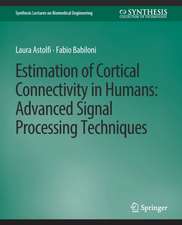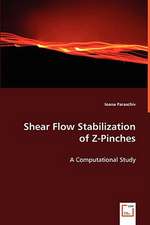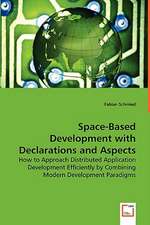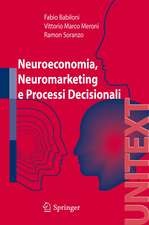The Graph Theoretical Approach in Brain Functional Networks: Theory and Applications: Synthesis Lectures on Biomedical Engineering
Autor Fabrizio Fallani, Fabio Babilonien Limba Engleză Paperback – 7 apr 2010
Din seria Synthesis Lectures on Biomedical Engineering
- 17%
 Preț: 362.02 lei
Preț: 362.02 lei - 15%
 Preț: 522.24 lei
Preț: 522.24 lei - 5%
 Preț: 364.74 lei
Preț: 364.74 lei - 5%
 Preț: 525.87 lei
Preț: 525.87 lei - 15%
 Preț: 636.80 lei
Preț: 636.80 lei -
 Preț: 382.95 lei
Preț: 382.95 lei -
 Preț: 268.83 lei
Preț: 268.83 lei -
 Preț: 260.77 lei
Preț: 260.77 lei -
 Preț: 266.32 lei
Preț: 266.32 lei -
 Preț: 265.18 lei
Preț: 265.18 lei -
 Preț: 262.47 lei
Preț: 262.47 lei -
 Preț: 204.76 lei
Preț: 204.76 lei -
 Preț: 268.66 lei
Preț: 268.66 lei -
 Preț: 262.47 lei
Preț: 262.47 lei -
 Preț: 206.84 lei
Preț: 206.84 lei -
 Preț: 321.54 lei
Preț: 321.54 lei -
 Preț: 192.05 lei
Preț: 192.05 lei -
 Preț: 261.32 lei
Preț: 261.32 lei -
 Preț: 261.53 lei
Preț: 261.53 lei -
 Preț: 349.36 lei
Preț: 349.36 lei -
 Preț: 260.95 lei
Preț: 260.95 lei -
 Preț: 204.76 lei
Preț: 204.76 lei -
 Preț: 391.02 lei
Preț: 391.02 lei -
 Preț: 268.83 lei
Preț: 268.83 lei -
 Preț: 205.92 lei
Preț: 205.92 lei -
 Preț: 382.57 lei
Preț: 382.57 lei -
 Preț: 346.48 lei
Preț: 346.48 lei -
 Preț: 264.41 lei
Preț: 264.41 lei -
 Preț: 384.48 lei
Preț: 384.48 lei -
 Preț: 259.04 lei
Preț: 259.04 lei -
 Preț: 260.95 lei
Preț: 260.95 lei -
 Preț: 261.32 lei
Preț: 261.32 lei -
 Preț: 158.66 lei
Preț: 158.66 lei -
 Preț: 267.86 lei
Preț: 267.86 lei -
 Preț: 207.65 lei
Preț: 207.65 lei -
 Preț: 205.92 lei
Preț: 205.92 lei -
 Preț: 268.66 lei
Preț: 268.66 lei -
 Preț: 322.31 lei
Preț: 322.31 lei -
 Preț: 205.70 lei
Preț: 205.70 lei -
 Preț: 226.22 lei
Preț: 226.22 lei - 15%
 Preț: 404.48 lei
Preț: 404.48 lei -
 Preț: 263.28 lei
Preț: 263.28 lei -
 Preț: 383.71 lei
Preț: 383.71 lei -
 Preț: 273.45 lei
Preț: 273.45 lei -
 Preț: 207.06 lei
Preț: 207.06 lei -
 Preț: 263.06 lei
Preț: 263.06 lei -
 Preț: 260.77 lei
Preț: 260.77 lei -
 Preț: 205.33 lei
Preț: 205.33 lei
Preț: 206.84 lei
Nou
Puncte Express: 310
Preț estimativ în valută:
39.58€ • 41.07$ • 33.08£
39.58€ • 41.07$ • 33.08£
Carte tipărită la comandă
Livrare economică 15-29 martie
Preluare comenzi: 021 569.72.76
Specificații
ISBN-13: 9783031005169
ISBN-10: 3031005163
Ilustrații: XII, 84 p.
Dimensiuni: 191 x 235 mm
Greutate: 0.18 kg
Editura: Springer International Publishing
Colecția Springer
Seria Synthesis Lectures on Biomedical Engineering
Locul publicării:Cham, Switzerland
ISBN-10: 3031005163
Ilustrații: XII, 84 p.
Dimensiuni: 191 x 235 mm
Greutate: 0.18 kg
Editura: Springer International Publishing
Colecția Springer
Seria Synthesis Lectures on Biomedical Engineering
Locul publicării:Cham, Switzerland
Cuprins
Introduction.- Brain Functional Connectivity.- Graph Theory.- High-Resolution EEG.- Cortical Networks in Spinal Cord Injured Patients.- Cortical Networks During a Lifelike Memory Task.- Application to Time-varying Cortical Networks.- Conclusions.
Notă biografică
Fabrizio DeVico Fallani is a Research fellow in the Department of Human Physiology, University of Rome “Sapienza” (Subject - Development and application of brain network analyses in healthy and dis[1]eased human subjects). He is also a term-contract worker at the Neuroeletrical Imaging and Brain Computer Interface Laboratory. IRCCS “Fondazione S.Lucia” (Subject - Development and application of brain network analyses in healthy and diseased human subjects during cognitive and motor tasks). In 2005 he got his master’s degree in Computer Science Engineering at the University of Rome “Sapienza” (Thesis title - Advanced Methods for the Estimation of the Cortical Connectivity from high resolution EEG recordings in a group of Spinal Cord Injured Patients). In 2009, he got his PhD degree in Biophysics at the University of Rome “Sapienza”. (Thesis title - Theoretical Graph Approach to Brain Functional Networks from High-Resolution EEG). He also received the best PhD thesis prize on Biomedical signal processing and imaging awarded by the Italian National Group of Bioengineering. He has participated with both oral and poster presentations at more than 45 international conferences and has received several travel grants and visiting research grants. He is the author of more than 30 scientific articles in peer-reviewed journals and his H-index is 6. His current interests are in the field of graph theoretical approaches, cortical connectivity estimation, and Brain Computer Interface. Fabio Babiloni was born in Rome in 1961. He received his master’s degree in Electronic Engineering at the University of Rome “La Sapienza” and the PhD in Computational Engineering at the Helsinki University of Technology, Helsinki in the 2000 with a dissertation on the multimodal integration of EEG and fMRI. He is currently Associate Professor of Human Physiology at the Faculty of Medicine of the University of Rome “La Sapienza”, Rome, Italy. He is the author of more that 120 papers on bioengineeringand neurophysiological topics in international peer-reviewed scientific journals, and more than 250 contributions to conferences and book chapters. His total impact factor is more than 290 and his H-index is 26. His current interests are in the field of multimodal integration of EEG, MEG and fMRI data, cortical connectivity estimation and Brain Computer Interface. Prof. Babiloni is currently grant reviewer for the National Science Foundation (NSF) USA ,the Academy of Finland, Finland, the Austrian Fund of Research, Austria and the European Union through the FP6 and FP7 research programs. Prof. Babiloni is president of the International Society of Functional Source Imaging, member of the Italian Society of Physiology and the Italian Society of Clinical Neurophysiology. He is an Associate Editor of four scientific Journals “Frontiers in Neuroscience,” “International Journal of Bioelectromagnetism,” “IEEE Trans. On Neural System and Rehabilitation Engineering,” and “Computational Intelligence and Neuroscience.”

























